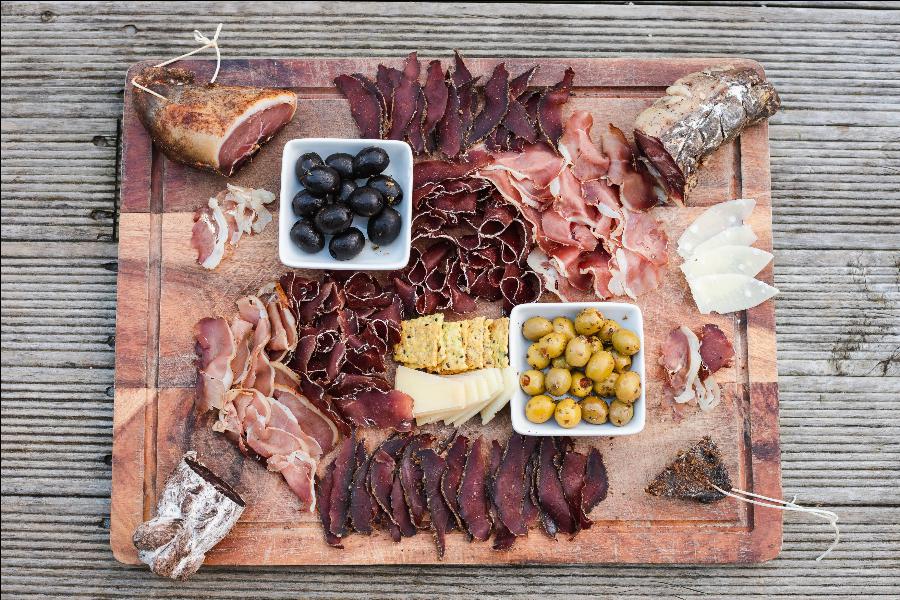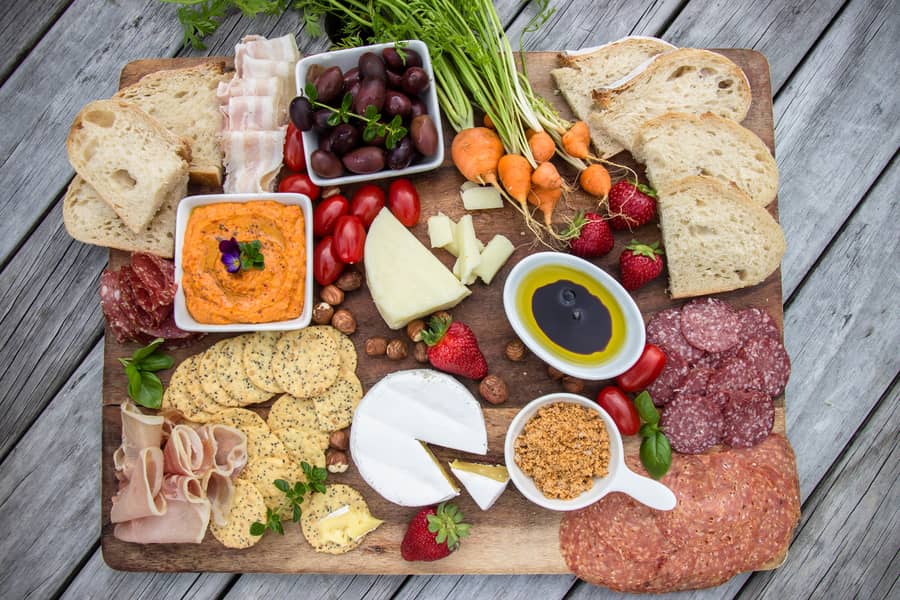Charcuterie (cured meat) is all the rave, but how much do you need per person? This is especially true for charcuterie boards and antipasti platters.
Delightfully delicate, savory, and rich, charcuterie and all that this cured meat platter offers will wow your guests. If you are the host, using charcuterie is a fantastic way to provide food for everyone’s varying palette while still pleasing their appetite.
How Much Charcuterie (cured meat) is Needed per Person? If Charcuterie (cured meat) is being provided as an appetizer, 1 to 3 oz of meat per person is sufficient. 6 oz per person when the charcuterie is the main course. Varying non-meat foods will help the platter to go farther.
Here is a helpful calculator to give you estimates:
Charcuterie Board Calculator

So here’s the short answer as a guide, and then let’s go on to whether you are doing a full ‘grazing’ main course or starter options.
Of course, over-purchase is always safer than running out of food to serve your beloved family and friends.
In this case, you might store some additional cured meat (here in an article I wrote on storing cured meat) before bringing it to the platter. Then, if your supply begins to run low, you will have plenty to go around.
Whole dry-cured salami is a good option since it’s preserved anyway and can be used for weeks or months in the fridge before drying out too much.
With dry-cured meats like salami, pancetta, and prosciutto, remember that they have lost 35% of their fresh meat weight. So, less goes much further for a charcuterie board! It’s compact protein!
How Much Charcuterie Do I Need for a Party?
If you are the clever host who has decided to serve charcuterie for your party, then you will surely please your guests and create that socializing factor that only comes from shared plates of food.
They will be wowed at the delightful presentation that comes with your savory cured meat and additional garnishes (fold the meat maybe like this:)


Regardless of their natural food inclinations, this option will surely hit the spot.
That said, there are a few additional things to remember when serving Charcuterie as the main course.
You will want to consider foods that will complement the cured meat, any beverages that you would like to serve, and the flavor profile that you hope to create in your sole component or the spread of many.
Charcuterie When it is the Main Course
When hosting a gathering and planning to feed your guests solely with a charcuterie display, you will need to double what you would otherwise offer if this were simply a tasting.
In this case, you should consider eating at least 5oz of meat per person, with 6oz being the standard.
Even if you are considering charcuterie (salami is definitely part of it, I wrote a little more on that here) as the main course, you should still provide additional foods to complement the rich, savory flavor of the various cured meats you choose to include.
You can keep it simple with bread, cheese, and a full-bodied glass of wine. Or, you can spice it up with a myriad of other choices.
- nuts
- dukkah
- balsamic in olive oil
- pestos – sundried tomato or basil
- seasonal fresh organic (or homegrown) sweet vegetables – carrots, cherry tomatoes
Either way, when you are serving charcuterie as the main course, your guests will be assuming that they will go home full from a delicious tasting on this platter.
Though it is a different form of serving the traditional dinner, its purpose remains the same. This is why you now see charcuterie spreads on fine dining menus worldwide.
Charcuterie When It Is Not the Main Course
Perhaps you have decided to use charcuterie as the appetizer before you begin the rest of your meal.
In this case, you can expect to use much less cured meat than if the platter were the main course.
You can estimate approximately 1 to 3 oz of meat per person when serving charcuterie, not as the main course.
This should always be accompanied by additional charcuterie board components such as cheese, bread, nuts, fruit, or other selections. Paired with a nice drink, your guests are sure to be pleased.
Again, you can get creative with what you choose to include on the charcuterie board (here is what to do with leftover charcuterie meats) when serving it as an appetizer, like the above little list.
There are plenty of non-meat options for charcuterie boards that will add some flair to your presentation and enhance the flavor profile of your meal.
As people become more and more creative, you can really enjoy the new twist on a French classic tradition.
How Much Does Charcuterie Cost?
Depending on the size of your guest list, charcuterie can be a realistic option, or it might seem a bit out of reach.
Fortunately for you, there are ways to make charcuterie (you can make the board ahead of time too) work for your menu regardless of the size of your budget.
I’ll use USD dollars since most visitors are from those parts of the world.
Charcuterie platters can cost as little as $30 to create for a small gathering,
Or you can spend more than $100 creating a more luxurious spread.
The choice is ultimately up to you as you decide on the types and quantity of cured meats (examples of cured meats from across the world) as well as additional charcuterie board components.
To make a budget-friendly charcuterie board, be sure to consider additional options that your guests are sure to love.
Bread is a good filler, so just make sure it’s fresh and of high quality. The easiest way is to know the maker was passionate!
One of the beautiful things about serving charcuterie is that there will be a flavor for everyone, and you get to showcase your style. You choose the meats, the additional food selections, and how the food is displayed.
Your guests enjoy whichever foods they feel up for that day.
If they are looking for a higher-quality, more dense meal, they can load up on the carbs and protein options available on your charcuterie board.
But, if they are looking for a light snack, you would hopefully have added this type of selection as well. The creative decisions are in your hands – fruit or vegetables are not evil!

Tom Mueller
For decades, immersed in studying, working, learning, and teaching the craft of meat curing, sharing the passion and showcasing the world of charcuterie and smoked meat. Read More

Thank you Tom for your information on this type of appys. I run a large b&b and thinking of offering this type of side dish for my guests. This charcuterie platter looks great, in the winter we don’t have many options in our area for meals so this could be a great addition. Look forward to giving this a try.
Cheers!
Cindy Shaurette
Honeycomb Bed & Breakfast
honeycombbb7@gmail.com
On ankle MB. Canada
Cool Cindy, preserved meat too lasts for a long time. I use reuseable sous vide bags so suck the air out, using a hand pump or hose attachment of vac pac machine so my dry-cured meats can sit in the fridge for years potentially.
You just need to invest in a decent deli slicer, if you haven’t got one. I did a lot of traveling around Italy, just about every house had a deli slicer for antipasti before dinner! Cheers Tom
I’m thinking of doing this for our daughter’s wedding. Wondering which is more cost effective. Catering or trying to do this myself. 150 guests. 😳
Do it yourself with some creativity 🙂
Buy whole muscle cured meats, maybe find a local butcher who is will to use the deli slicer to slice it wafer thin! 🙂
Cheers
Tom
just wondering, if you are having charcuterie plus other items, how much meat and cheese per person, if there is 100 people? thanks
depends on how many eat meat 🙂 I would say maybe 3-6 slices of fine dry cured charcuterie (whole muscle or salami) per person. Also, a pre-dinner/event may alter this? Cheers T
Hi Tom.
I just learned I have been tagged to do hors d’oeuvres for a wedding of 150 people in 3 weeks and she would like a charcuterie grazing board. 3 oz meat per person is very helpful. I will be adding lots of fruits and veggies too. How much cheese would you recommend? And do you think 1-6 foot long table would hold enough food for this size event? Thanks!
Hey good luck, I’ve never done a wedding planning consultation!
6 slices per person? Im guessing! depends on size of slice too!
If it were me I would create topography on the table! Make it 3D !
Cheers
T